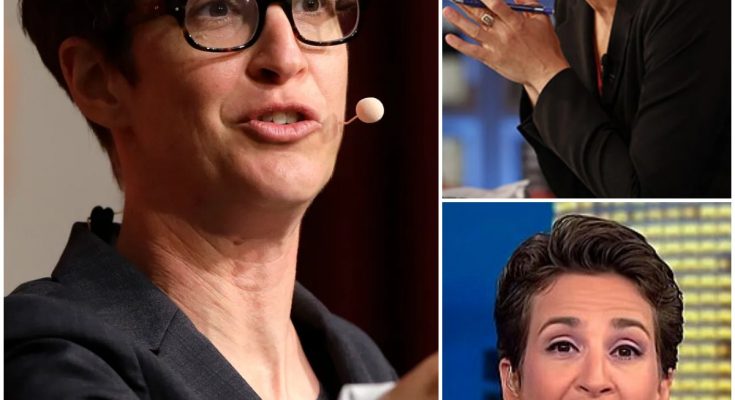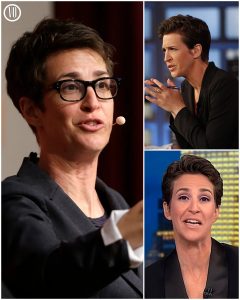In a media landscape dominated by legacy networks and corporate interests, few names command as much respect—or provoke as much controversy—as Rachel Maddow. Known for her incisive analysis and fearless commentary, Maddow has spent years as a fixture on cable news, building a loyal following and shaping the national conversation. But behind the scenes, a seismic shift is underway—one that could upend the entire industry.
Whispers of Change
It began as a rumor, whispered in newsrooms and exchanged in encrypted messages among media insiders: Rachel Maddow, the face of primetime progressive news, was quietly exploring an exit from her corporate home. Not for another network, but for something entirely new—a fully independent news channel, built from the ground up and beholden to no one but its audience.
Sources close to Maddow describe a months-long process of secret meetings, legal consultations, and late-night strategy sessions. The vision was audacious: a network with no corporate sponsors, no advertising pressure, and no editorial interference. For Maddow, it was about reclaiming her voice—and, perhaps, setting a new standard for journalism in the process.

The Breaking Point
For years, Maddow has navigated the delicate balance between speaking truth to power and operating within the constraints of a massive media conglomerate. Her on-air candor has won her accolades and enemies alike. But according to those familiar with her thinking, the tipping point came when network executives began to tighten their grip—demanding changes to content, pushing for more “sponsor-friendly” segments, and quietly shelving stories deemed too controversial.
“She’s always valued her independence,” says one former producer. “But lately, it felt like every word was being scrutinized, every topic weighed against the bottom line. She knew she couldn’t do her best work under those conditions.”
A Bold Plan Emerges
Determined to break free, Maddow assembled a small, trusted team to explore her options. The goal: to create a news platform built on transparency, integrity, and fearless reporting. No sponsors to appease. No corporate bosses to answer to. Just the truth, delivered without compromise.
The plan called for a digital-first approach, leveraging streaming technology and direct audience support. Subscribers would fund the network, ensuring that editorial decisions were driven by journalistic values—not advertising revenue. Maddow envisioned a slate of original programming, investigative specials, and live coverage of major events—all produced with the same rigor and passion that made her a household name.
The Pushback
But as word of the project began to leak, resistance quickly mounted. Behind closed doors, network executives scrambled to keep Maddow in the fold, offering lucrative contract extensions and promises of greater creative control. According to insiders, the stakes were high: losing Maddow would not only mean losing a ratings juggernaut, but also risking a mass exodus of viewers loyal to her brand of journalism.
And then, the pressure turned ugly. Confidential sources describe a campaign of intimidation and misinformation, designed to undermine Maddow’s confidence and sow doubt among her allies. Legal threats were floated. Confidentiality agreements were invoked. At least one senior executive reportedly warned Maddow that “going rogue” would mean professional exile.

The Moment of Truth
Despite the mounting obstacles, Maddow pressed on. In recent weeks, she has quietly met with investors, tech partners, and fellow journalists interested in joining the venture. The response, by all accounts, has been electric. “People are hungry for something real,” says a source involved in the talks. “They’re tired of the same sanitized, sponsor-approved news. Rachel’s offering a way out.”
But the path forward is anything but certain. Launching an independent network in an era of media consolidation is a daunting task, requiring not just vision, but resources, infrastructure, and unwavering resolve. Maddow’s team is reportedly exploring partnerships with progressive media outlets, as well as crowdfunding options to ensure the network’s financial independence.
The Story Leaks
Now, as the full story begins to slip out, the media world is buzzing with speculation. Will Maddow succeed in building a new home for independent journalism? Can she withstand the pressure from powerful interests determined to keep her silent? And what does her rebellion say about the state of American media in 2025?
For many, Maddow’s gamble is a test case for the future of news. If she succeeds, it could inspire a wave of defections from corporate media, empowering journalists to reclaim their craft. If she fails, it will serve as a cautionary tale about the enduring power of the status quo.

What’s at Stake
At the heart of the story is a simple but profound question: Who controls the news? For decades, the answer has been a handful of corporations, driven by profit and beholden to advertisers. Maddow’s bid for independence challenges that model, insisting that journalism must serve the public, not the shareholders.
Her supporters argue that the stakes couldn’t be higher. “This is about more than one anchor or one network,” says a longtime colleague. “It’s about whether we’re going to have a press that’s free to tell the truth, or one that’s chained to the interests of the powerful.”
The Road Ahead
As Maddow weighs her next move, the industry watches with bated breath. Her exit, if it happens, will mark the end of an era—and the beginning of a new experiment in media independence. Already, other journalists are reportedly reaching out, eager to join a platform where editorial




